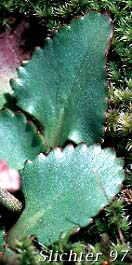 Leaves of the western saxifrage
(var. alleni) at right.
Leaves of the western saxifrage
(var. alleni) at right.
Also known as Alberta saxifrage, western saxifrage is a perennial with single, simple stems arising from 5-20 cm high from a cluster of several basal leaves. The stems arise from a short rhizome, are short-hairy, and are often reddish-glandular. The thick leaf blades are elliptical or egg-shaped, or occasionally roughly triangular in outline with coarsely toothed margins (15-30 teeth). The blade tapers gradually to a broad, winged petiole, or occasionally rather abruptly to the petiole, giving the leaf in that case a triangular outline. The blades are 2-5 cm long and to 3 cm wide and glabrous above and may be rusty-haired beneath.
The inflorescence is a narrow to moderately open cyme with the 2-8 side branches ascending or close to the stem. The pedicels range from 2-7 mm long. The reflexed calyx lobes are 1.5-2.5 mm long, triangular with rounded to obtuse tips. The white petals are 1.5-3.5 mm long, egg-shaped and without a claw at their base. The filaments are awl- or narrowly club-shaped with both forms sometimes present in the same inflorescence. They range from 1.8-2.6 mm long while the orange-brown stamens are 0.25-0.5 mm long. The 2 styles are short and divergent.
Western saxifrage recently consisted of 6 varieties, but 4 of these have been split out to make 3 new species, several of which are not found east of the Cascade Mts, which are listed below. Plants of the remaining 2 varieties, var. allenii and var. wallowensis remain in this species but are not currently recognized as distinct varieties. They are listed below to emphasize their differences.
variety allenii: Filaments not petal-like but thinly club-shaped. Petals never have 2 yellow dots near their base. Inflorescence more congested, pyramidal, the branches ascending, greater than 5 cm long during flowering. Found along the east side of the Cascade mts at fairly high elevations from Mt. Rainier south to Mt. Adams and into the Columbia River Gorge.
variety wallowensis (formerly var. occidentalis): Filaments not petal-like but thinly club-shaped. Petals never have 2 yellow dots near their base. Inflorescence more congested (about 5 cm long in flower, up to 10 cm in fruit), pyramidal, the 2-6 branches short & closely ascending. Plants deeply tinged with dark red. Found both west and east of the Cascade Mts and east through British Columbia to Alberta and south through the Rocky Mts. to Wyoming and hence west to western Idaho and the Wallowa Mts of northeastern Oregon.
Gorman's saxifrage Saxifraga gormanii (formerly S. occidentalis variety dentata): Filaments not petal-like, thinner or awl-shaped. Petals never have 2 yellow dots near their base. Inflorescence open, pyramidal, the branches spreading, greater than 5 cm long during flowering. Leaves narrow abruptly to long, thin petioles nearly as long as the blade. Inflorescence densely haired with short, purple- to red-tipped hairs. Found along the Columbia River from the western Gorge west to its mouth and south to Tillamook County in Oregon.
Idaho Saxifrage Saxifraga idahoensis (formerly S. occidentalis variety idahoensis): Filaments like thin petals, club-shaped, widest in the middle. Petals sometimes with 2 yellow dots near their base. Found from the foothills of the Wenatchee Mts. (Tumwater Canyon), in the lower basin of the Clearwater River of Idaho, and the lower Snake River Canyon of Idaho and Oregon.
Saddle Mountain saxifrage Saxifraga hitchcockiana (formerly S. occidentalis variety latipetiolata): Filaments not petal-like, mostly thinner, awl-shaped. Petals never have 2 yellow dots near their base. Inflorescence open, pyramidal, the branches spreading, greater than 5 cm long during flowering. Leaves gradually narrow to the short, wide petiole. Inflorescence densely haired with wavy, yellow gland-tipped hairs. Found on Saddle Mt and Onion Peak of Clatsop County, OR.
Rustyhair saxifrage Saxifraga rufidula (formerly S. occidentalis var. rufidula): Filaments not petal-like, sometimes thinnly club-shaped or often not. Petals always lack 2 yellow dots near their base. Inflorescence flat-topped, the branches ascending and longer than 5 cm long at flowering. The inflorescence is strongly purple-tinged. Found mostly west of the Cascade Mts. to the Pacific Coast from British Columbia south to northwestern Oregon and up the Columbia River Gorge to Wasco County in Oregon.
Western saxifrage may be found on seasonally moist (spring) slopes, cliffs, and and streambanks from sea level to alpine habitats.
Western saxifrage may be found from British Columbia south on both sides of the Cascades to northwest Oregon, and east across Oregon and Washington to Idaho, Montana, northwestern Wyoming and the Black Hills of South Dakota, and as far south as Elko County, Nevada. In Canada, it may be found as far east as southern Alberta.
Western saxifrage (former variety rufidula ?) from Catherine Creek, Major Creek Plateau, Columbia River Gorge, Washington........March 2, 1997 ( left) and the same location......March 30, 1991 (right).